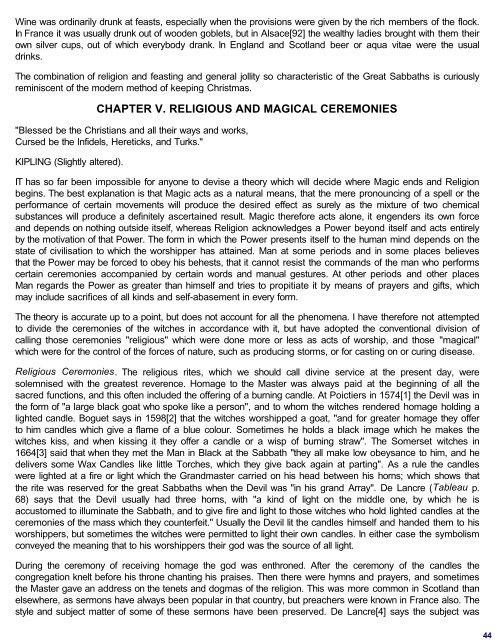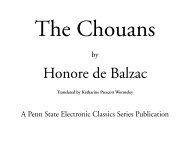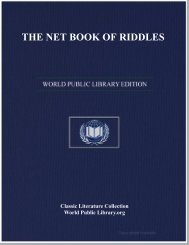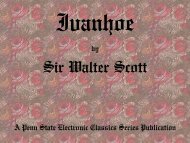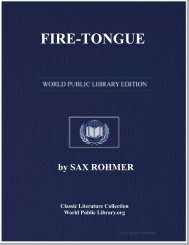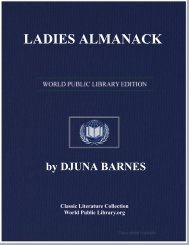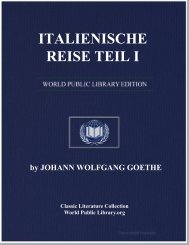THE GOD OF THE WITCHES - World eBook Library - World Public ...
THE GOD OF THE WITCHES - World eBook Library - World Public ...
THE GOD OF THE WITCHES - World eBook Library - World Public ...
You also want an ePaper? Increase the reach of your titles
YUMPU automatically turns print PDFs into web optimized ePapers that Google loves.
Wine was ordinarily drunk at feasts, especially when the provisions were given by the rich members of the flock.<br />
In France it was usually drunk out of wooden goblets, but in Alsace[92] the wealthy ladies brought with them their<br />
own silver cups, out of which everybody drank. In England and Scotland beer or aqua vitae were the usual<br />
drinks.<br />
The combination of religion and feasting and general jollity so characteristic of the Great Sabbaths is curiously<br />
reminiscent of the modern method of keeping Christmas.<br />
CHAPTER V. RELIGIOUS AND MAGICAL CEREMONIES<br />
"Blessed be the Christians and all their ways and works,<br />
Cursed be the Infidels, Hereticks, and Turks."<br />
KIPLING (Slightly altered).<br />
IT has so far been impossible for anyone to devise a theory which will decide where Magic ends and Religion<br />
begins. The best explanation is that Magic acts as a natural means, that the mere pronouncing of a spell or the<br />
performance of certain movements will produce the desired effect as surely as the mixture of two chemical<br />
substances will produce a definitely ascertained result. Magic therefore acts alone, it engenders its own force<br />
and depends on nothing outside itself, whereas Religion acknowledges a Power beyond itself and acts entirely<br />
by the motivation of that Power. The form in which the Power presents itself to the human mind depends on the<br />
state of civilisation to which the worshipper has attained. Man at some periods and in some places believes<br />
that the Power may be forced to obey his behests, that it cannot resist the commands of the man who performs<br />
certain ceremonies accompanied by certain words and manual gestures. At other periods and other places<br />
Man regards the Power as greater than himself and tries to propitiate it by means of prayers and gifts, which<br />
may include sacrifices of all kinds and self-abasement in every form.<br />
The theory is accurate up to a point, but does not account for all the phenomena. I have therefore not attempted<br />
to divide the ceremonies of the witches in accordance with it, but have adopted the conventional division of<br />
calling those ceremonies "religious" which were done more or less as acts of worship, and those "magical"<br />
which were for the control of the forces of nature, such as producing storms, or for casting on or curing disease.<br />
Religious Ceremonies. The religious rites, which we should call divine service at the present day, were<br />
solemnised with the greatest reverence. Homage to the Master was always paid at the beginning of all the<br />
sacred functions, and this often included the offering of a burning candle. At Poictiers in 1574[1] the Devil was in<br />
the form of "a large black goat who spoke like a person", and to whom the witches rendered homage holding a<br />
lighted candle. Boguet says in 1598[2] that the witches worshipped a goat, "and for greater homage they offer<br />
to him candles which give a flame of a blue colour. Sometimes he holds a black image which he makes the<br />
witches kiss, and when kissing it they offer a candle or a wisp of burning straw". The Somerset witches in<br />
1664[3] said that when they met the Man in Black at the Sabbath "they all make low obeysance to him, and he<br />
delivers some Wax Candles like little Torches, which they give back again at parting". As a rule the candles<br />
were lighted at a fire or light which the Grandmaster carried on his head between his horns; which shows that<br />
the rite was reserved for the great Sabbaths when the Devil was "in his grand Array". De Lancre (Tableau p.<br />
68) says that the Devil usually had three horns, with "a kind of light on the middle one, by which he is<br />
accustomed to illuminate the Sabbath, and to give fire and light to those witches who hold lighted candles at the<br />
ceremonies of the mass which they counterfeit." Usually the Devil lit the candles himself and handed them to his<br />
worshippers, but sometimes the witches were permitted to light their own candles. In either case the symbolism<br />
conveyed the meaning that to his worshippers their god was the source of all light.<br />
During the ceremony of receiving homage the god was enthroned. After the ceremony of the candles the<br />
congregation knelt before his throne chanting his praises. Then there were hymns and prayers, and sometimes<br />
the Master gave an address on the tenets and dogmas of the religion. This was more common in Scotland than<br />
elsewhere, as sermons have always been popular in that country, but preachers were known in France also. The<br />
style and subject matter of some of these sermons have been preserved. De Lancre[4] says the subject was<br />
44


